SAFE Secure Data Center Architecture Guide
Available Languages
Bias-Free Language
The documentation set for this product strives to use bias-free language. For the purposes of this documentation set, bias-free is defined as language that does not imply discrimination based on age, disability, gender, racial identity, ethnic identity, sexual orientation, socioeconomic status, and intersectionality. Exceptions may be present in the documentation due to language that is hardcoded in the user interfaces of the product software, language used based on RFP documentation, or language that is used by a referenced third-party product. Learn more about how Cisco is using Inclusive Language.
The Secure Data Center is a place in the network (PIN) where a company centralizes data and performs services for business. Data centers contain hundreds to thousands of physical and virtual servers that are segmented by applications, zones, and other methods. This guide addresses data center business flows and the security used to defend them.
The Secure Data Center is one of the six places in the network within SAFE. SAFE is a holistic approach in which Secure PINs model the physical infrastructure and Secure Domains represent the operational aspects of a network.
The Secure Data Center architecture guide provides:
● Business flows for the data center
● Data center threats and security capabilities
● Business flow security architecture
● Design examples and a suggested components
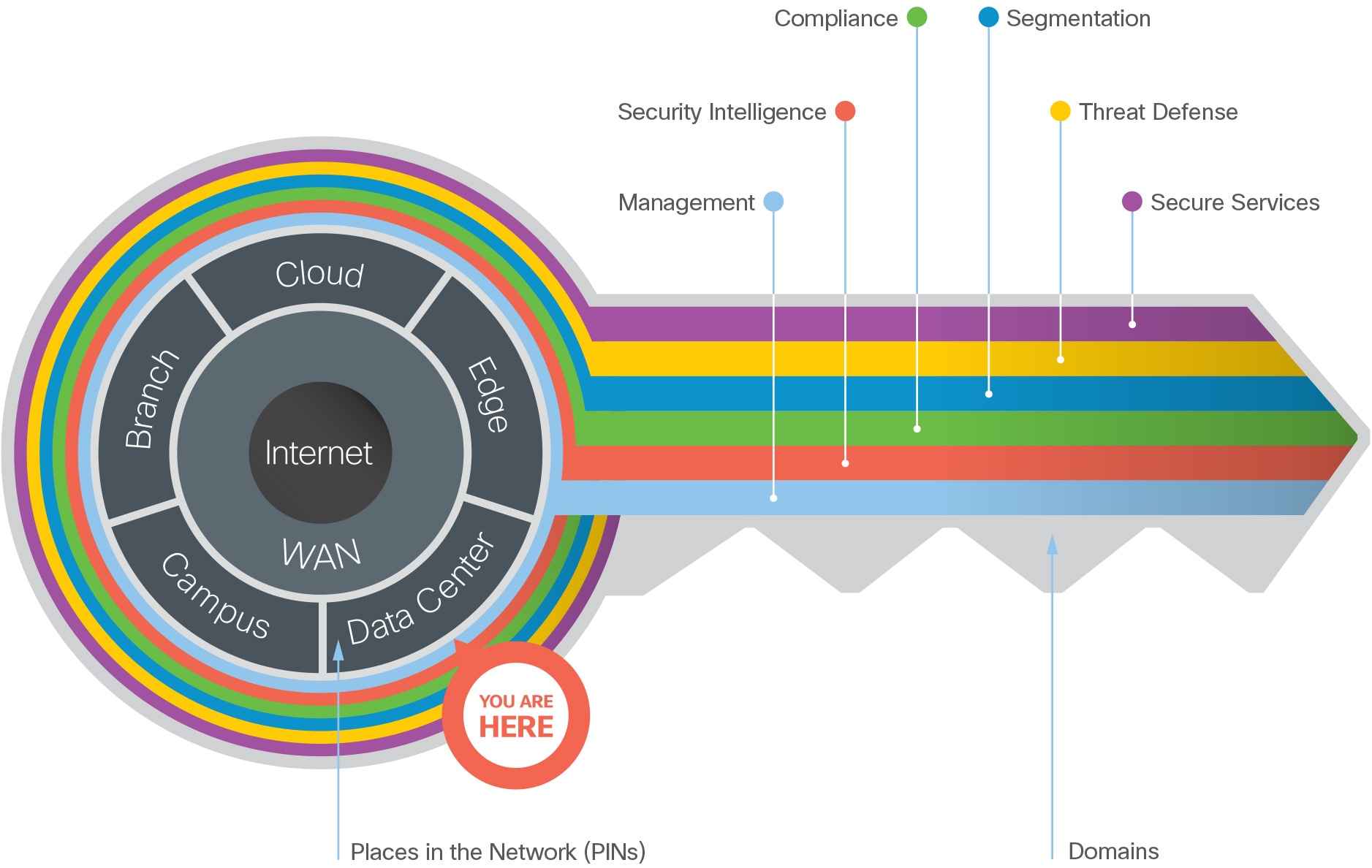
SAFE simplifies security by starting with business flows, then addressing their respective threats with corresponding security capabilities, architectures, and designs. SAFE provides guidance that is holistic and understandable.
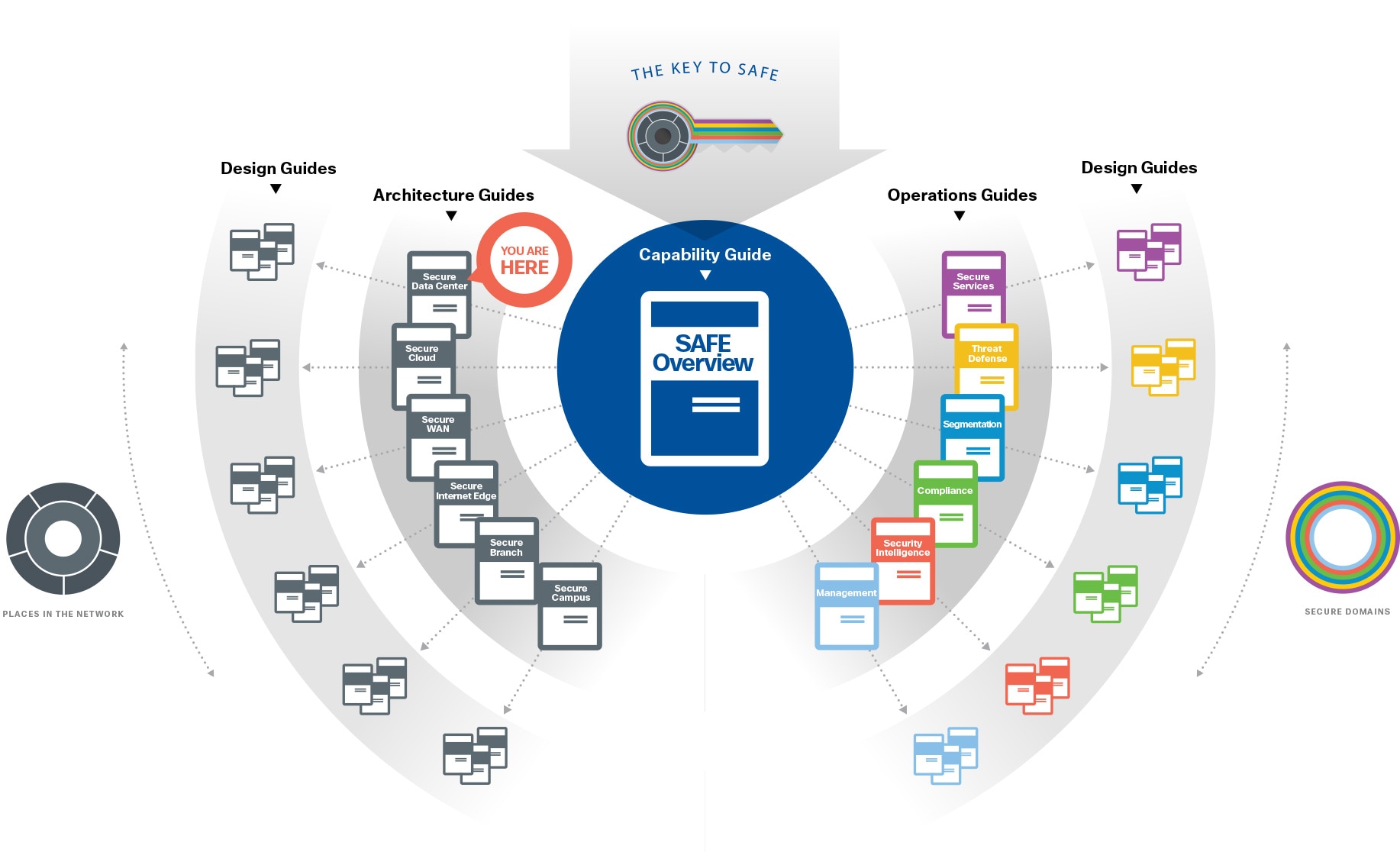
The Secure Data Center provides business services to the company’s users. It is the central destination and transit area that ties the company business flows together.
● Internally, employees in the branch, campus, and remote locations require access to applications, collaboration services (voice, video, email), and the Internet. Systems communicate east/west within and between data centers.
● Third parties, such as service providers and partners, require remote access to applications and devices.
● Customer guest traffic transits the network en route to the Internet edge.
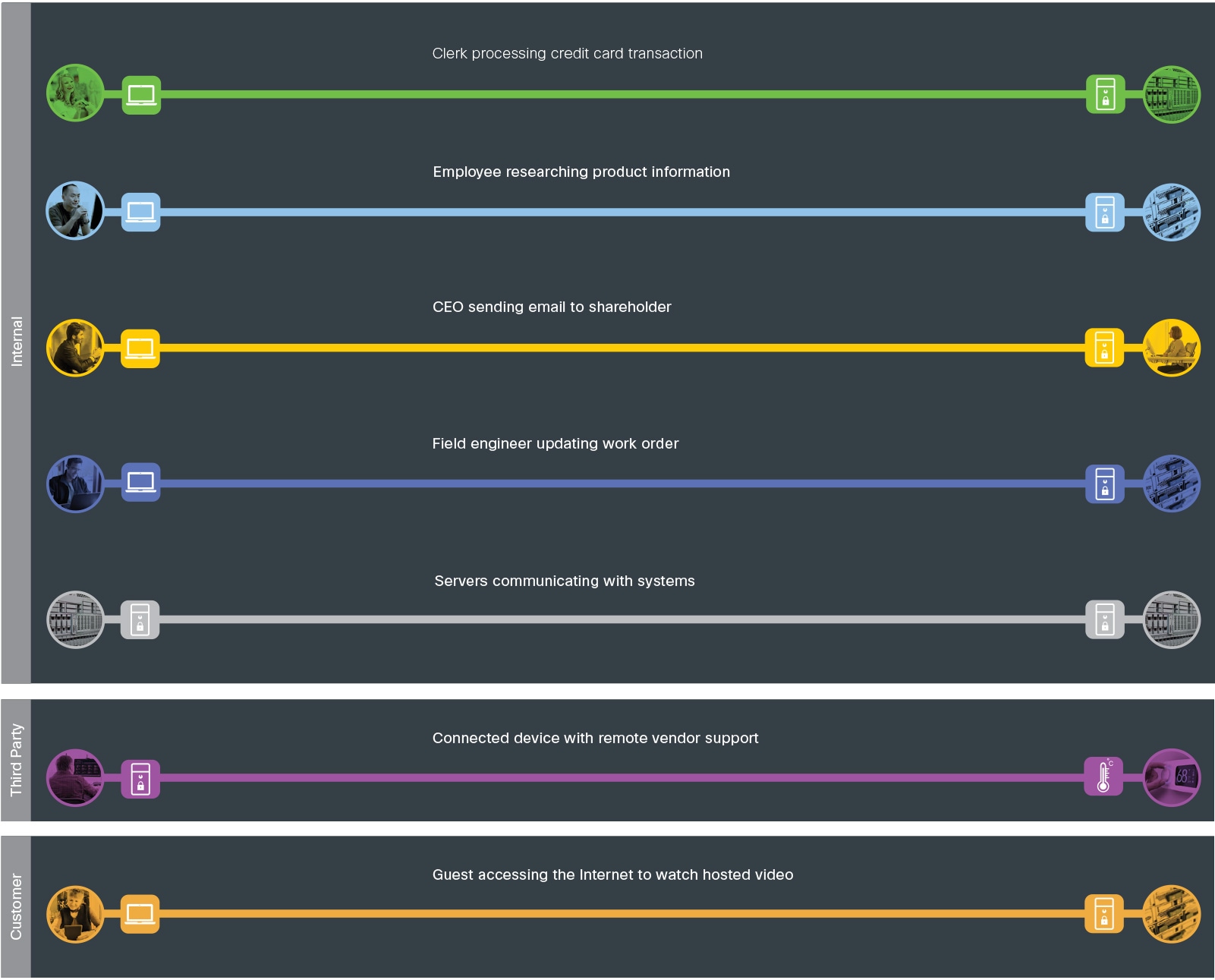
Functional controls are common security considerations that are derived from the technical aspects of the business flows.
| Functional Control |
Definition |
| Secure Applications |
Applications require sufficient security controls for protection. |
| Secure Access |
Servers and devices securely accessing the network. |
| Secure East/West Traffic |
Data moves securely; internally, externally, or to third-party resources. |
| Secure Remote Access |
Secure remote access for employees and third-party partners that are external to the company network. |
| Secure Communications |
Email, voice, and video communications connect to potential threats outside of company control and must be secured. |
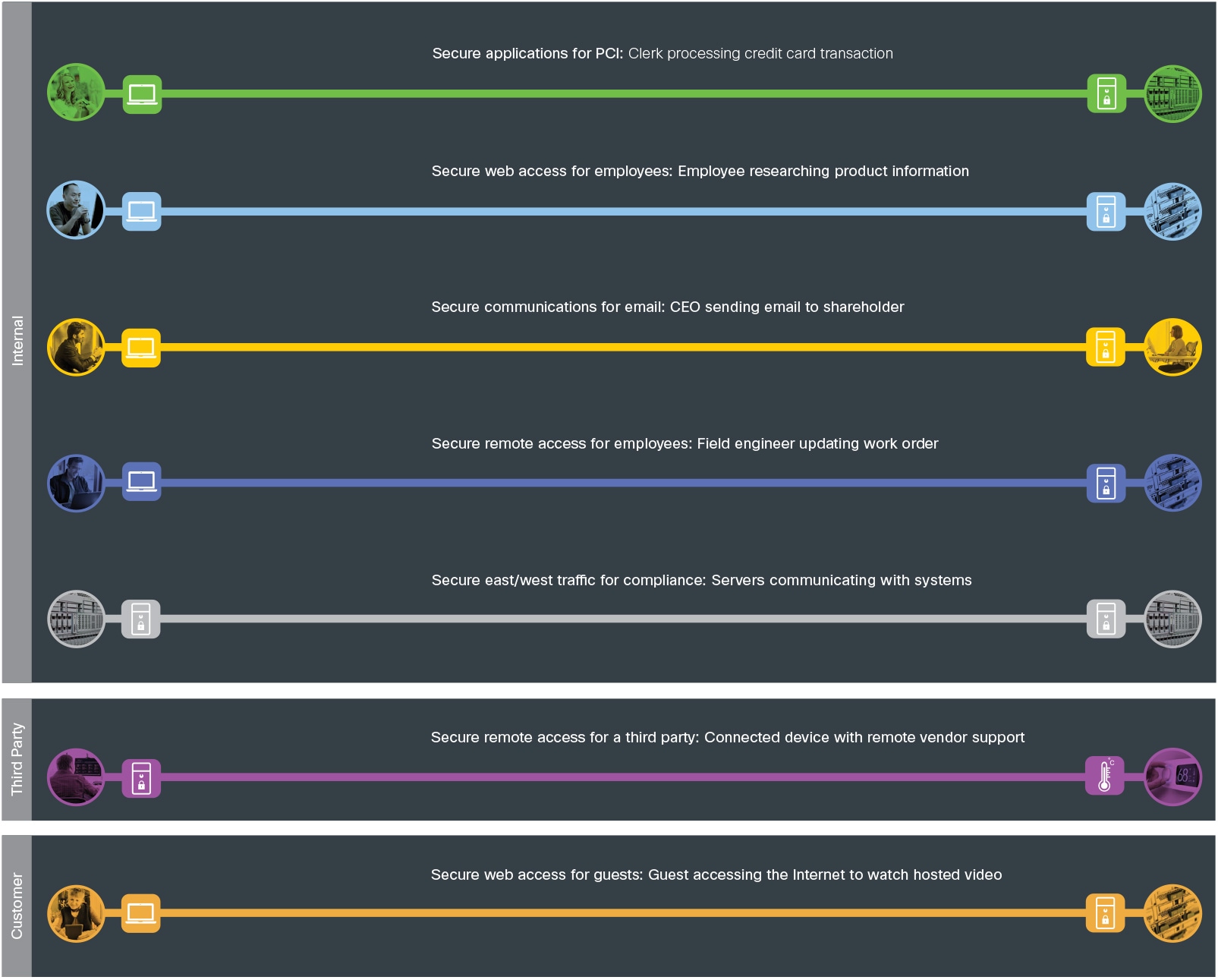
Data center security is simplified by grouping capabilities into three groups which align to the functional controls: Foundational, Business, and Access.
Each flow requires the access and foundational groups. Business activity risks require appropriate capabilities to control or mitigate them as shown in Figure 5, which often reside within the data center. User clients and devices also require security, but are non-data center capabilities.
For more information regarding capability groups and functional controls, refer to the SAFE overview guide.
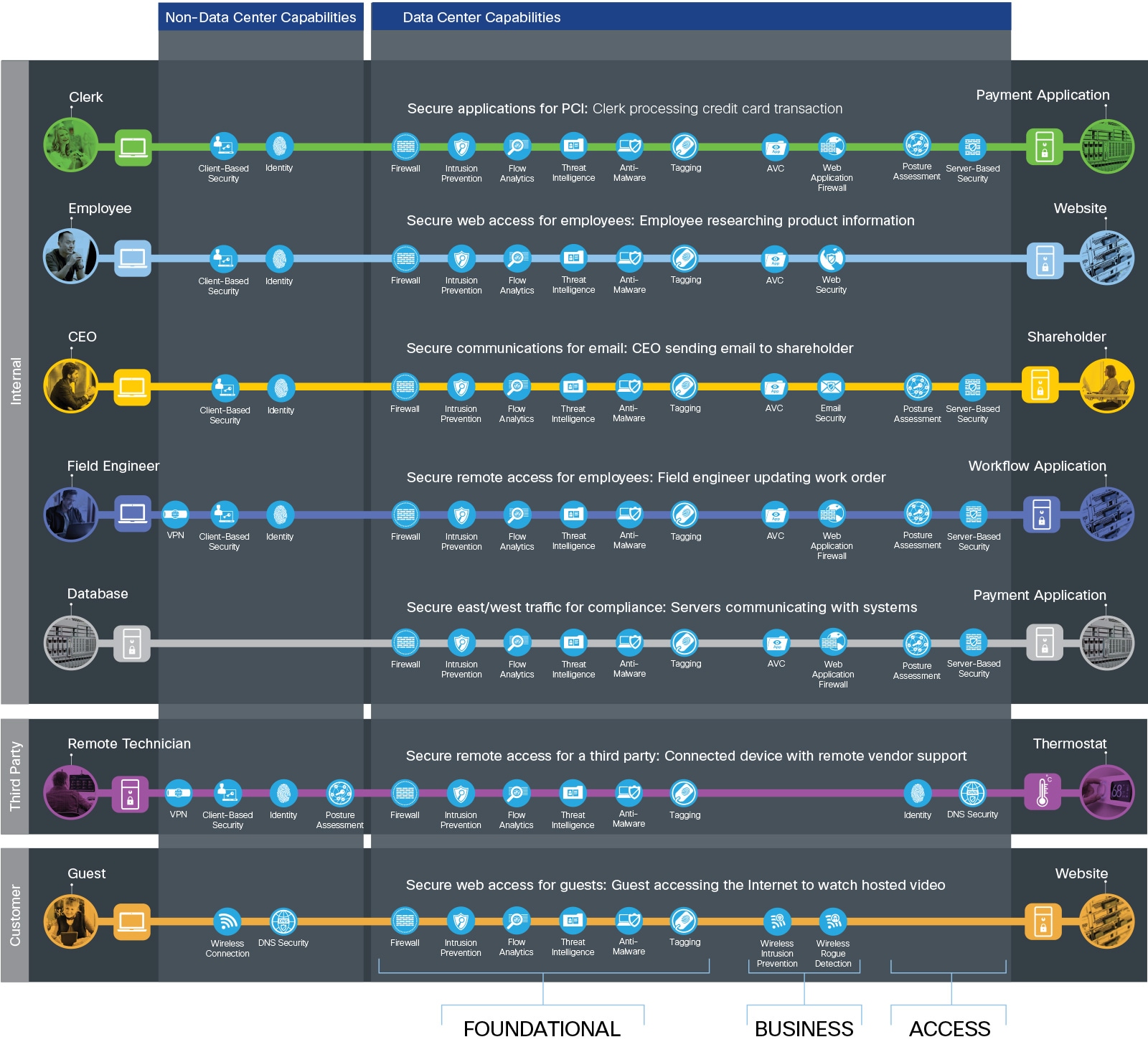
Secure Data Center threats and capabilities are defined in the following sections.
Data centers contain the majority of business information assets and intellectual property. These are the primary goals of targeted attacks and require the highest level of investment to secure. The data center has four primary threats:
Data extraction (data loss)
The unauthorized ex-filtration or theft of a company’s intellectual property, innovation, and proprietary company data.
Unauthorized network access
Unauthorized access gives attackers the potential to cause damage, such as deleting sensitive files from a host, planting a virus, and hindering network performance with a flood of illegitimate packets.
Malware propagation
Assets in the data center are targets for east/west contamination between servers, and north/south from employees, partners, or customer devices on the network. Applications that process credit card transactions and Internet of Things devices are the most prevalent targets.
Botnet cultivation
The resources of a server farm are a valuable target for botnet cultivation. Botnets are networks made up of remote controlled computers, or “bots.” They are used to steal data, send spam, or perform other attacks.

The defense is explained throughout the rest of the document.
The attack surface of the data center is defined by the business flows, and includes the people and the technology present. The security capabilities that are needed to respond to the threats are mapped in Figure 6. The data center security capabilities are listed in Table 1. The placement of these capabilities is discussed in the architecture section.
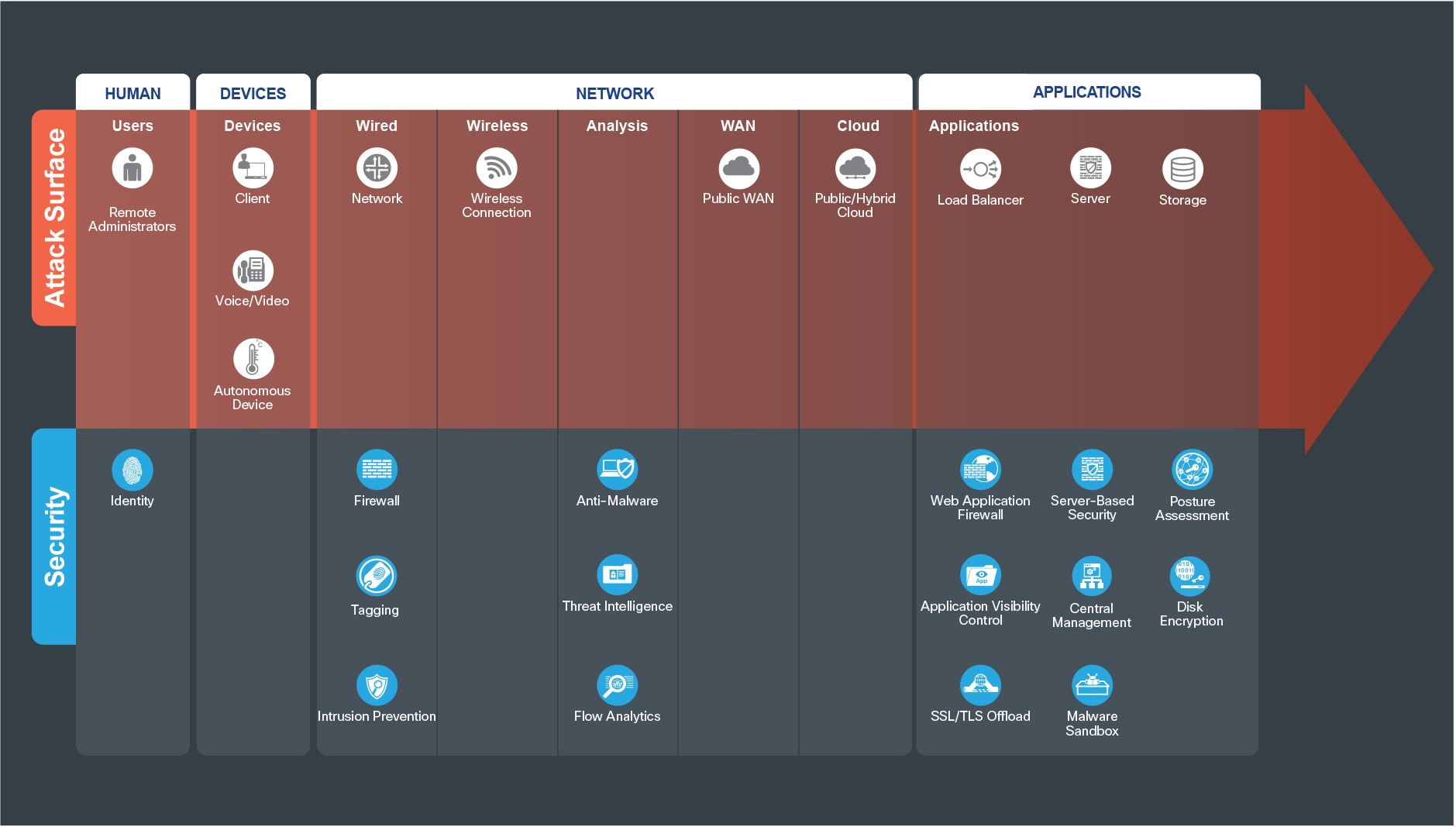
The suggested products that implement these capabilities can be found in Appendix B.

Users: Employees, third parties, customers, and administrators.
| Security Capability |
Threat |
||
|
|
Identity: Identity-based access. |
|
Attackers or disgruntled admins accessing restricted information resources. |
Network Attack Surface – Wired Network

Wired Network: Physical network infrastructure; routers, switches, used to connect access, distribution, core, and services layers together.
| Security Capability |
Threat |
||
|
|
Firewall: Stateful filtering and protocol inspection between segments in the data center. |
|
Unauthorized access and malformed packets between and within the data center. |
|
|
Intrusion Prevention: Blocking of attacks by signatures and anomaly analysis. |
|
Attacks using worms, viruses, or other techniques. |
|
|
Tagging: Software-based segmentation using Endpoint Groups (EPGs)/TrustSec/VLANs. |
|
Unauthorized access and malicious traffic between segments. |
Network Attack Surface - Analysis

Analysis: Analysis of network traffic withing the campus.
| Security Capability |
Threat |
||
|
|
Anti-Malware: Identify, block, and analyze malicious files and transmissions. |
|
Malware distribution across networks or between servers and devices. |
|
|
Threat Intelligence: Contextual knowledge of existing and emerging hazards. |
|
Zero-day malware and attacks. |
|
|
Flow Analytics: Network traffic metadata identifying security incidents. |
|
Traffic, telemetry, and data exfiltration from successful attacks. |
Applications Attack Surface - Applications

Management, servers, database, load balancer.
| Security Capability |
Threat |
||
|
|
Application Visibility Control: Inspects network communications. |
|
Unauthorized access and malformed packets connecting to services. |
|
|
Central Management: Company-wide management, monitoring, and controls. |
|
Single target for complete company control and destruction. |
|
|
Malware Sandbox: Inspects and analyzes suspicious files. |
|
Zero-day malware and attacks. |
|
|
TLS Encryption Offload: Accelerated encryption of data services. |
|
Theft of unencrypted traffic. |
|
|
Web Application Firewall: Advanced application inspection and monitoring. |
|
Attacks against poorly developed applications and website vulnerabilities. |
Applications Attack Surface - Storage

Storage: Drives, databases, media.
| Security Capability |
Threat |
||
|
|
Disk Encryption: Encryption of data at rest. |
|
Theft of unencrypted data. |
Applications Attack Surface - Servers

| Security Capability |
Threat |
||
|
|
Server-based Security: Security software for servers with the following capabilities: |
|
|
|
|
Anti-Malware: Identify, block, and analyze malicious files and transmissions. |
|
Malware distribution across servers. |
|
|
Anti-Virus: |
|
Viruses compromising systems. |
|
|
Cloud Security: Security services from the cloud |
|
Redirection of session to malicious website. |
|
|
Host-based Firewall: Provides micro-segmentation and policy enforcement. |
|
Unauthorized access and malformed packets connecting to server. |
|
|
Posture Assessment: Server compliance verification, authorization, and patching. |
|
Targeted attacks taking advantage of known vulnerabilities. |
|
|
Disk Encryption: Encryption of data at rest. |
|
Theft of unencrypted data. |
|
|
Flow Analytics: Network traffic metadata identifying security incidents. |
|
Traffic, telemetry, and data exfiltration from successful attacks. |
|
|
Application Dependency Mapping: |
|
Exploiting a misconfigured firewall policy. |
|
|
Vulnerability Assessment and Software Inventory: |
|
Exploiting unpatched or outdated applications. |
|
|
Process Anomaly Detection & Forensics: |
|
Exploiting privileged access to run shell code. |
|
|
Tagging: Grouping for Software Defined Policy |
|
Unauthorized access and malicious traffic between segments. |
|
|
Policy Generation, Audit, and Change Management: |
|
Targeted attacks taking advantage of known vulnerabilities. |

Management, Control, and Monitoring
| Security Capability |
Threat |
||
|
|
Analysis/Correlation: Security event management of real-time information. |
|
Diverse and polymorphic attacks. |
|
|
Anomaly Detection: Identification of infected hosts scanning for other vulnerable hosts. |
|
Worm traffic that exhibits scanning behavior. |
|
|
Identity/Authorization: Centralized identity and administration policy. |
|
Single target for complete company control and destruction |
|
|
Logging/Reporting: Centralized event information collection. |
|
Unauthorized network access or configuration. |
|
|
Monitoring: Network traffic inspection. |
|
Traffic, telemetry, and data ex-filtration from successful attacks. |
|
|
Policy/Configuration: Unified infrastructure management and compliance verification. |
|
Seizure of infrastructure or devices. |
|
|
Time Synchronization: Device clock calibration. |
|
Misdirection and correlation of attacks. |
|
|
Vulnerability Management: Continuous scanning, patching, and reporting of infrastructure. |
|
Unauthorized access to system-stored data. |
SAFE underscores the challenges of securing the business. It enhances traditional network diagrams to include a security-centric view of the company business. The Secure Data Center architecture is a logical grouping of security and network technology that supports data center use cases. It implements a traditional access/distribution/core network architecture as well as application-centric server farm.
SAFE business flow security architecture depicts a security focus. Traditional design diagrams that depict cabling, redundancy, interface addressing, and specificity are depicted in SAFE design diagrams. Note that a SAFE logical architecture can have many different physical designs.
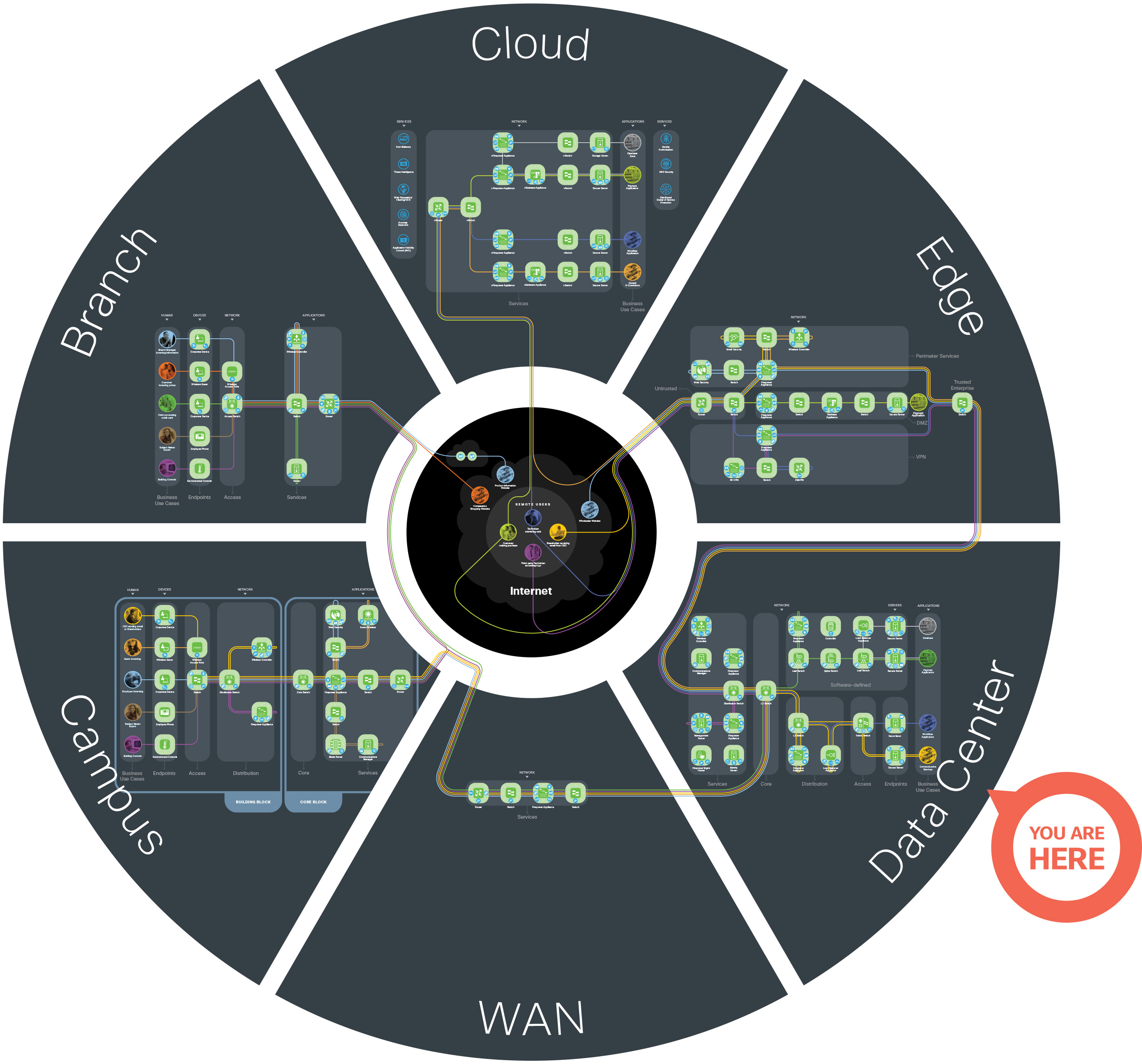
The Secure Data Center architecture has the following characteristics:
● Visibility with centralized management, analytics, and shared services
● A core connecting distribution and application-centric layers
● Redundant high-performance appliances for availability and maximum uptime
● Modular access and distribution layers which dynamically segment applications
● Software-defined network segmentation, orchestration
● Software-defined application segmentation
● Virtual servers requiring secure network access connectivity
Humans and devices are part of the attack surface, but are not part of the architecture within the data center. Data centers are often deployed within a campus or corporate headquarters.

The Secure Data Center attack surface (Figure 6) consists of Humans, Devices, Network, and Applications. A successful breach gives an attacker the “keys to the kingdom”.
Security includes these considerations:
● Human administrators are located outside of the data center
● Devices are autonomous vs. operated by users
● Network security is enhanced by comprehensive physical security
● Applications and data contain vital company information
● Hosted by company-wide, centralized management
● Application orchestration centralizes control of security, network, and server elements into a single critical target
The sections below discuss the security capability that defends the threats associated with each part of the surface.
Typically, humans in the data center are administrators. No amount of technology can prevent successful attacks if the administrators themselves are compromised.
Administrators that are disgruntled (fired, demoted, bullied, ideology), compromised (blackmail, threats, bribery), or have had their credentials stolen (phishing, key logger, password reuse) are the single biggest risk in the security of a company.
Administrators have a higher level of access than normal users which requires additional controls:
● Two-factor authentication
● Limited access to job function
● Logging of administrator changes
● Dedicated, restricted workstations
● Removal of old administrator accounts
Server farms that host Virtual Desktops (VDI) enable remote users to access shared resources for everyday applications and should be segmented appropriately.
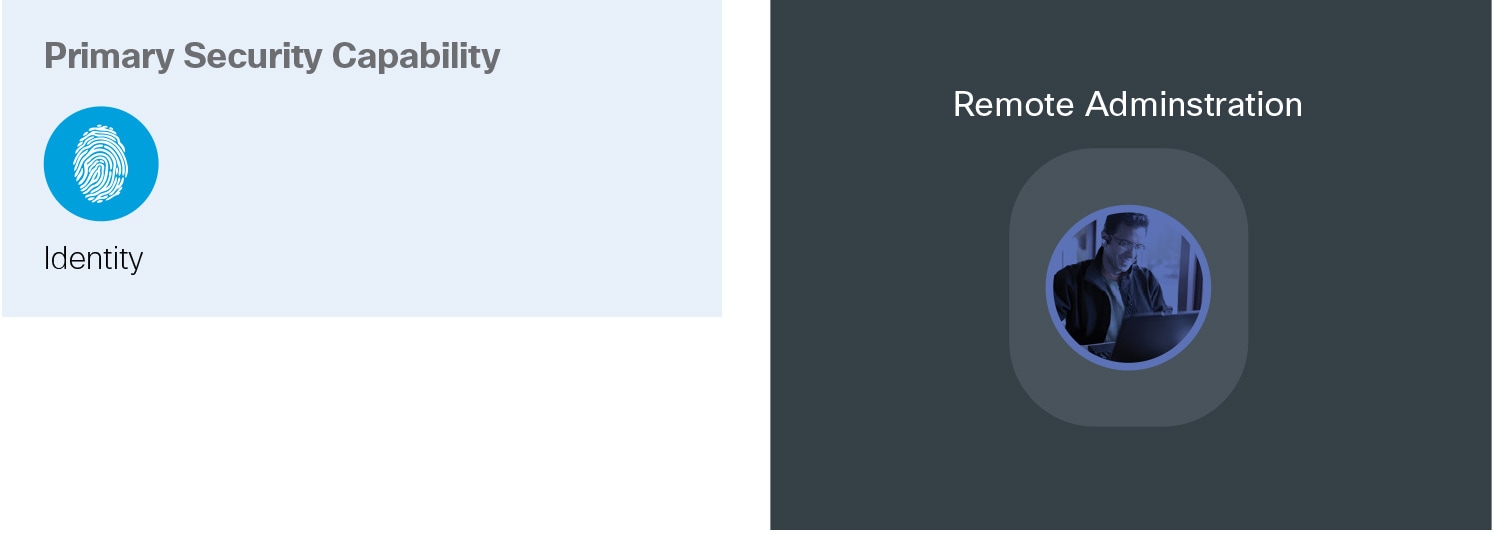
The devices for the data center are tools that administrators use to control and monitor systems that maintain and secure the data center.
Remote administrators connect to centralized management systems using secure connectivity with strong encryption (SSH, TLS, VPN) and multi-factor authentication from a variety of devices.
Control and monitoring systems (e.g., HVAC, power distribution, fire control) provide services to the data center and attach
Administrator systems and autonomous IoT devices connect to the services layer or the adjacent campus network, not in the server farm of the data center. Capabilities provided there must implement posture assessments, patching, and enhanced security controls which should be enforced for these devices. Access policies that must be applied to administrator devices include time of day, geography, and role.in the services layer.
Compromising these systems is a direct threat to the data center (e.g., if you turn off the A/C, you will burn up the servers—a Denial of Service attack).
The capabilities to protect these devices are found in the associated campus network that the data center is deployed within.
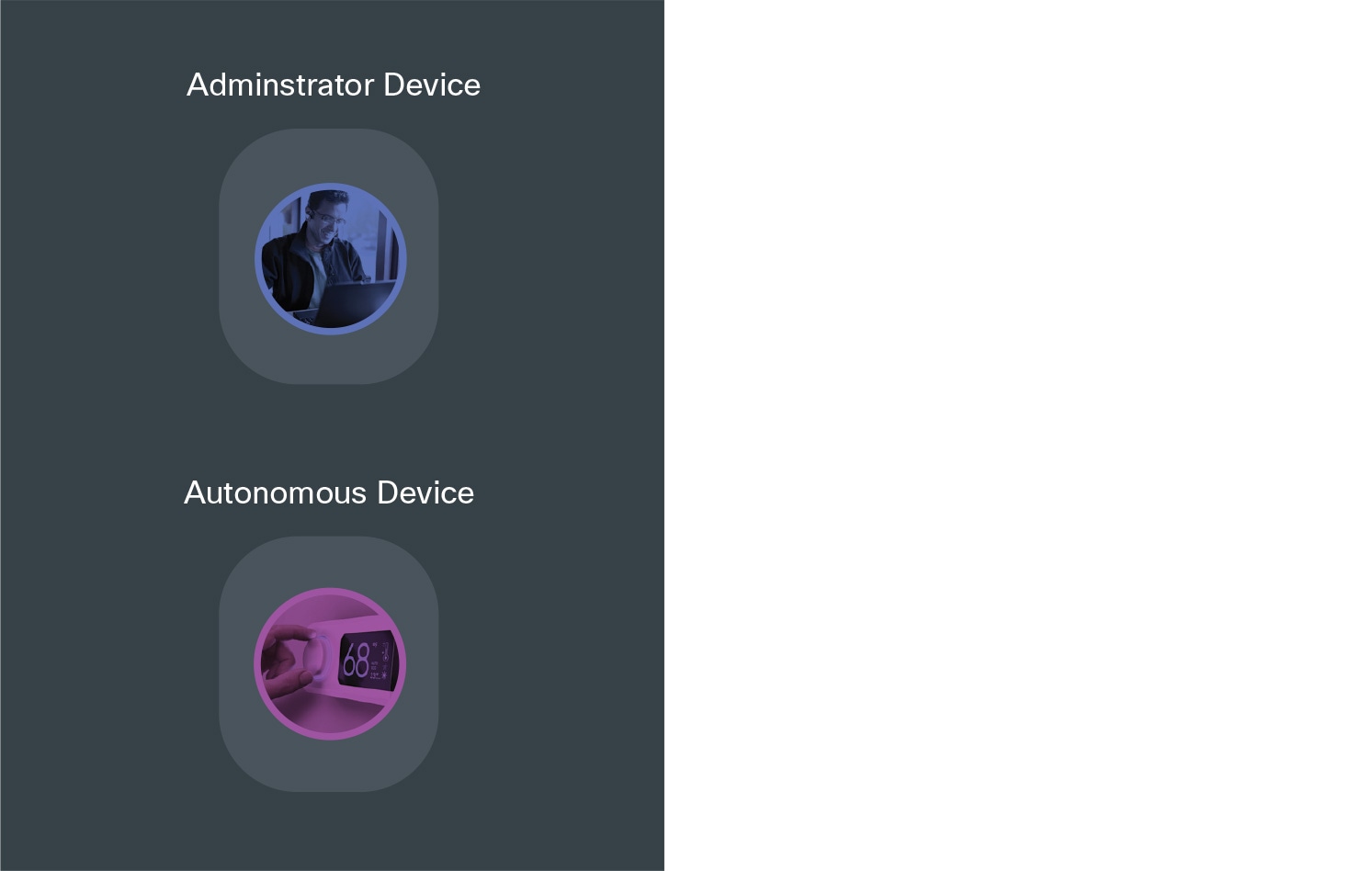
The access/distribution/core is classic network hierarchy. These layers provide a method which discretely separates services for business-based traffic into flows, and allows scale as services are moved, added, or changed. Application-centric infrastructure enhances policy enforcement through orchestrated, software-defined segmentation across a flat topology. These organizations simplify network troubleshooting and segment traffic for security. Visibility into these flows using flow analytics provides insight to protect against data extraction.
The access layer is where servers are attached to the network. Its purpose is to enforce compliance to policy and prevent unauthorized network access.
Flow analytics provide visibility to network traffic and enable the identification of anomalies. Anomalous behavior and other attacks can then be quarantined appropriately.
This layer connects to the distribution layer.
Distribution layers segregate network traffic between the access layer and the core layer.
They provide scalable services to the access layer and endpoints (e.g., firewall, intrusion prevention, load balancing, TLS offload). High-speed access and availability are the primary design considerations.
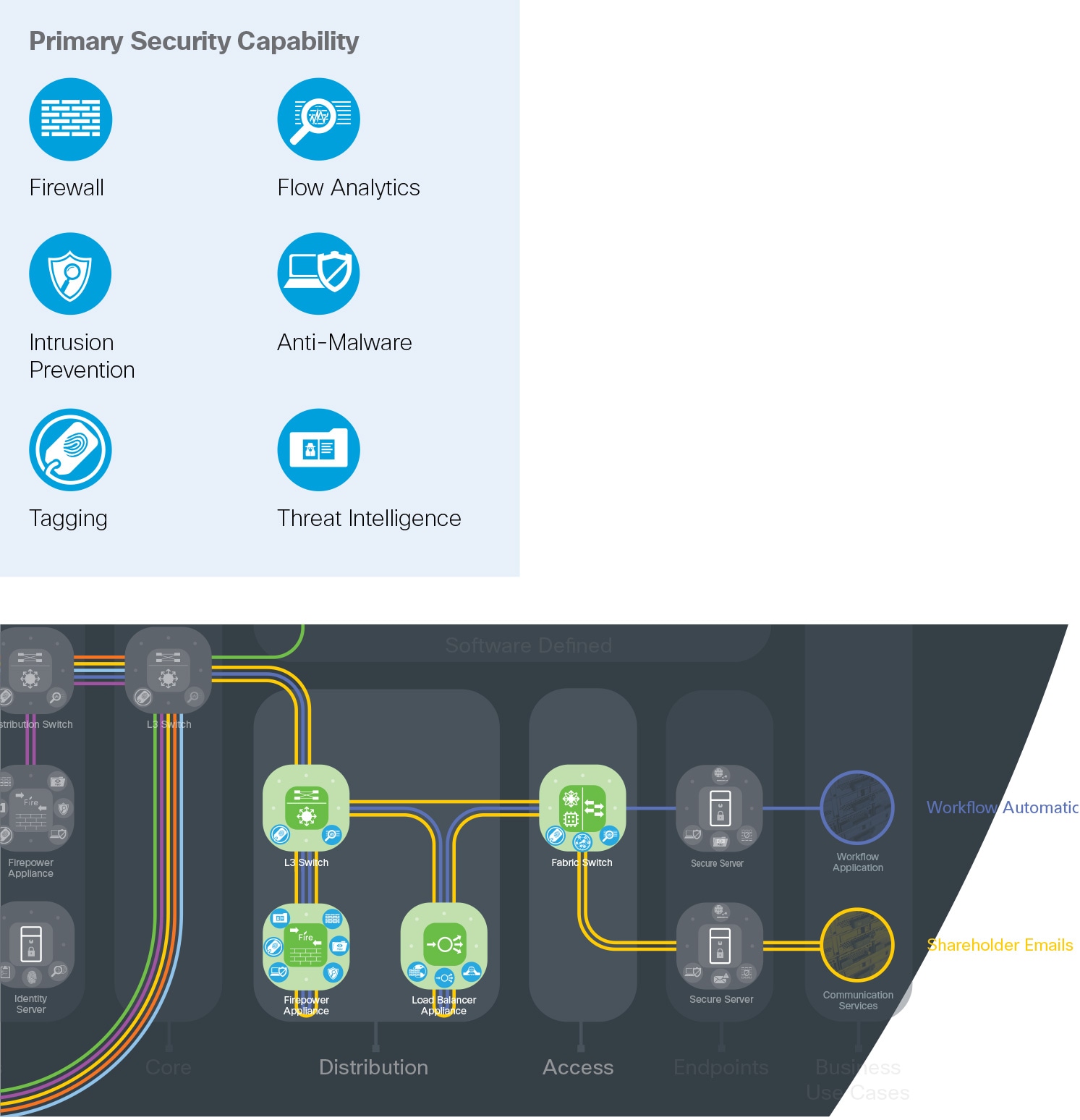
The Software-defined Data Center (SDDC) is a layer in the data center with an open, programmable fabric which enables automation, agility, security, and analytics. It integrates virtual and physical workloads in a multi-hypervisor fabric to build a multi-service, hybrid, or cloud data center. The configurable fabric consists of discrete components that operate as compute, storage, networking, security, and availability, but is provisioned and monitored as a single entity. It enhances policy enforcement through orchestrated, software-defined segmentation across a flat topology, enabling better business agility.
Segmentation is implemented by grouping endpoints, and services are applied to traffic between groups using contracts to prevent unauthorized network access.
Leaf and spine layers connect the core to the servers. These provide a distribution method of services that discretely separates business-based traffic into flows based on applications, and allows scale as services are moved, added, or changed.
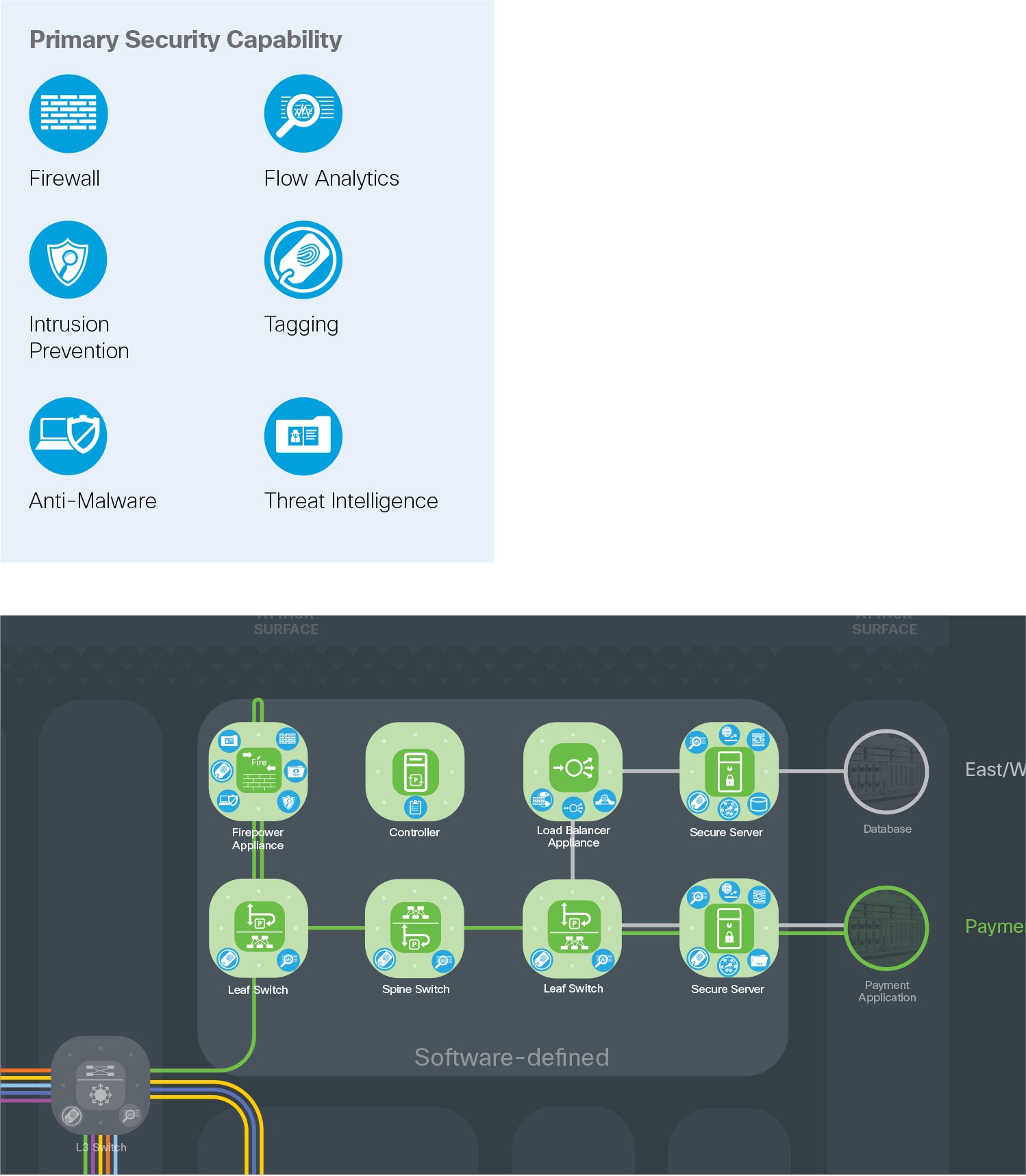
The core network provides high-speed, highly redundant connectivity to route packets between distribution-layer devices and different areas of the network.
The location of deployment varies from small to large companies, where the data center is deployed within a campus or independently of other PINs.
The core layer requires flow analytics for visibility, and tagging for segmentation.
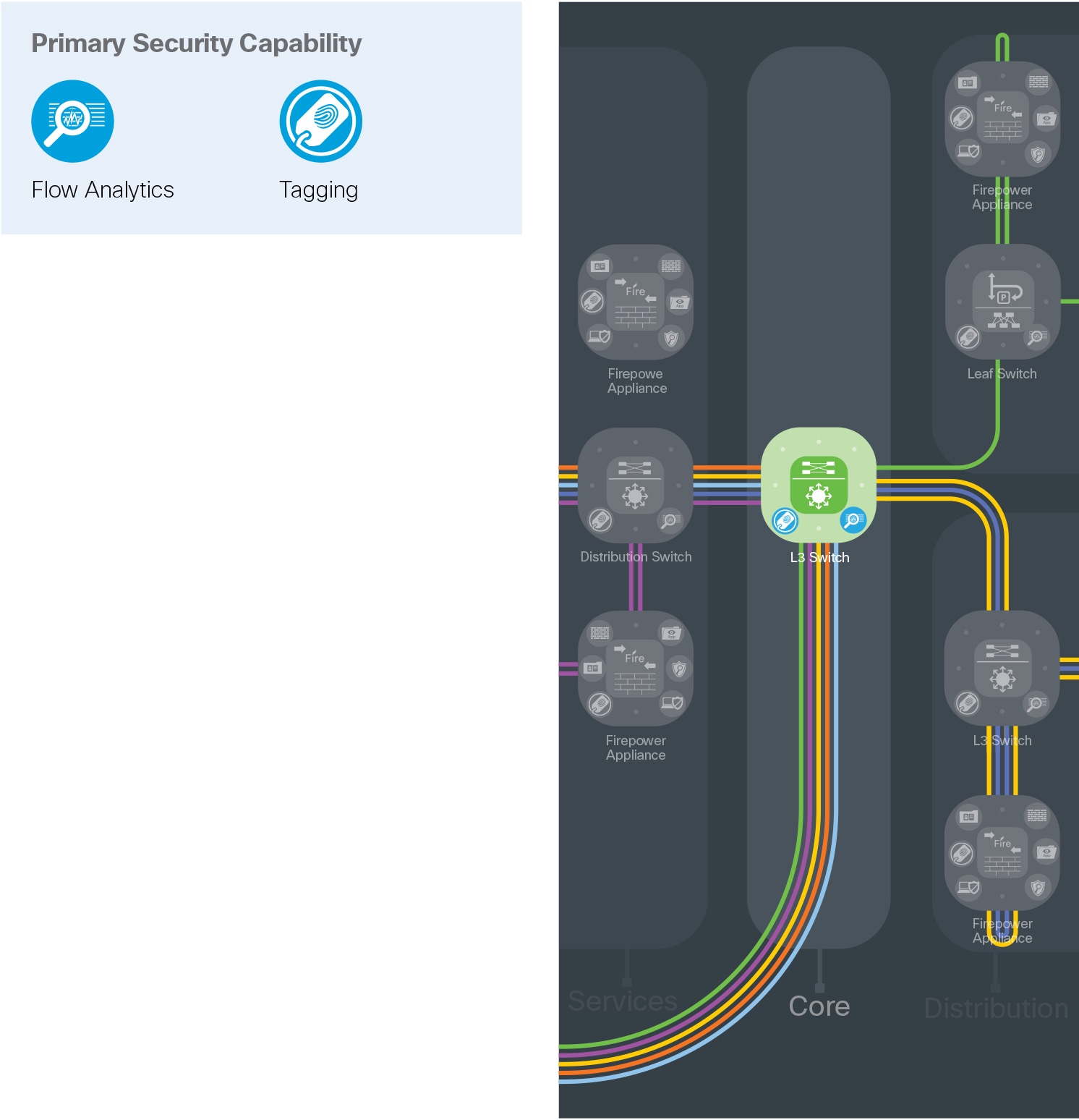
The services layer is a special collapsed distribution and access layer within a data center. It hosts supporting capability services for the data center and other places in the network. A high-security section contains the management, monitoring, and communications infrastructure. Unified wireless controllers, WIPS, and voice systems are also centrally managed for other PIN locations.
Independent management networks and data center devices connect here (e.g., HVAC, security cameras, power control systems).
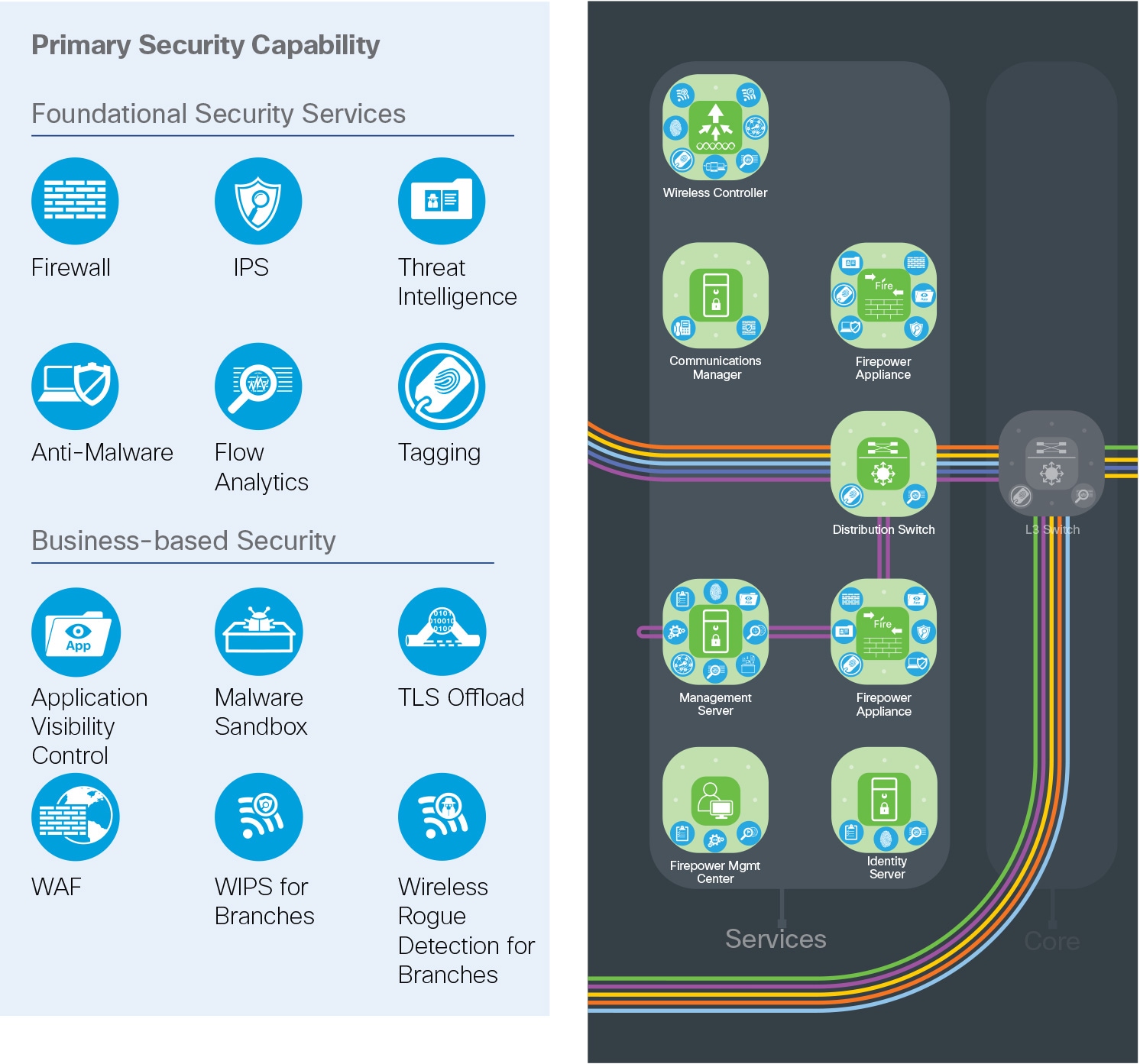
The services layer also hosts many common services utilized across the company. Identity management using products like Cisco Identity Services Engine (ISE) is integrated with common identity platforms such as Microsoft Active Directory to better manage identity-based access and control policies. Network devices use protocols such as RADIUS and TACACS to securely authenticate administrators to these services when managing infrastructure.
Time synchronization within a company is a fundamental necessity for security certificate exchange and accurate log/event correlation.
Host and domain name resolution services are often directed to the Internet in branch locations. But in the data center, local servers are deployed for security and speed of replies.
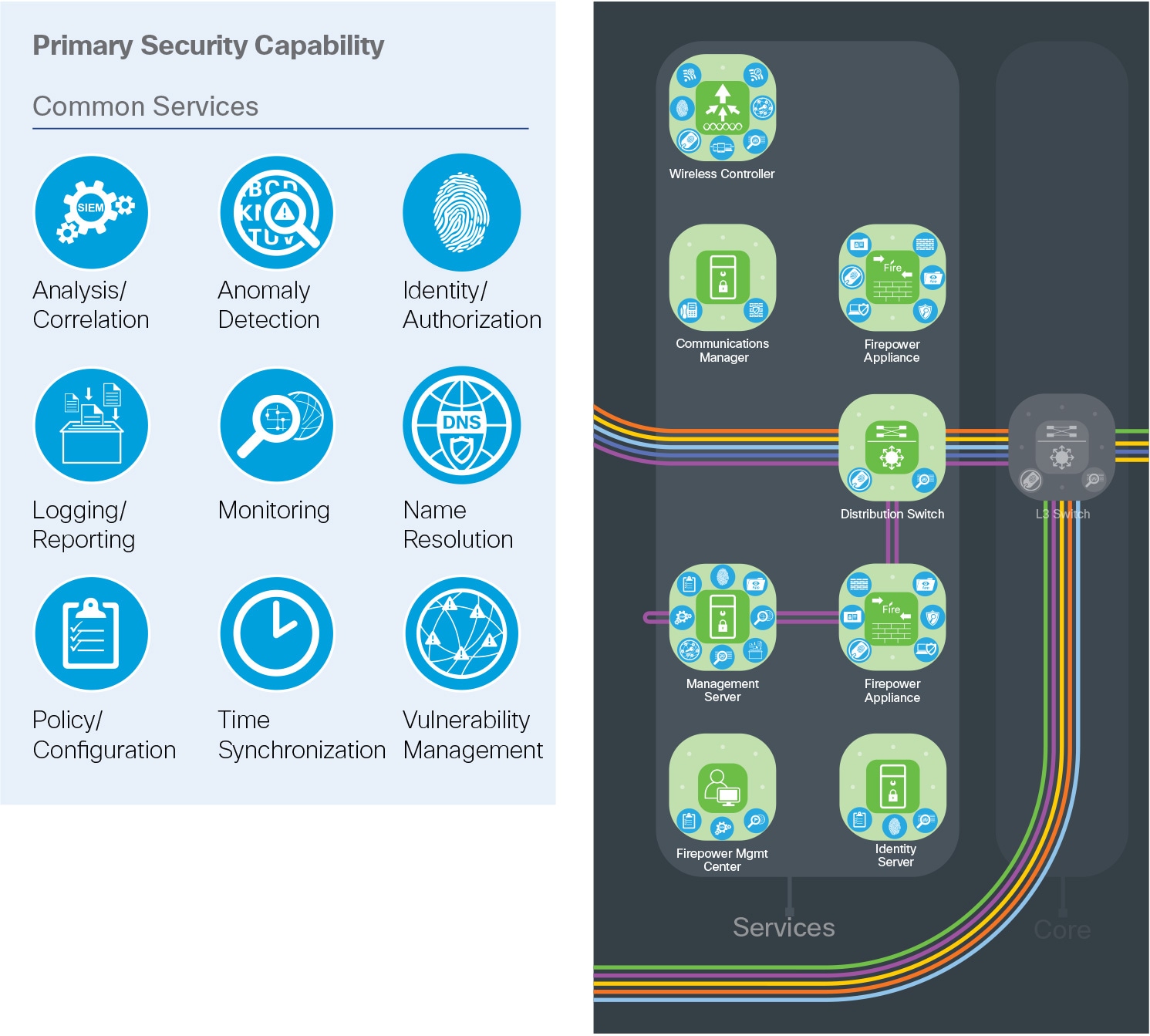
Servers are the business flow endpoints in a data center that host web services, applications, and databases. Collectively these clusters or farms provide capabilities beyond a single machine, and often consist of thousands of computers. To ensure reliability they include redundancy with automatic fail-over and rapid re-configuration.
Malware propagation, botnet infestation, and a large attack surface are threats targeting servers.
Server-based security is achieved through deployment of host-based firewalls, anti-malware, and anti-virus products in addition to software sensors which add visibility, enforcement, and package management such as Cisco Secure Workload (Tetration).
East/west traffic refers to the communication between servers within an application tier (web, application, database) as seen in Figure 15. This workload traffic pattern can be secured by policies between them which implement application micro-segmentation, behavior baselining/analysis, vulnerability detection, and intrusion prevention, which are tuned to meet the application requirements.
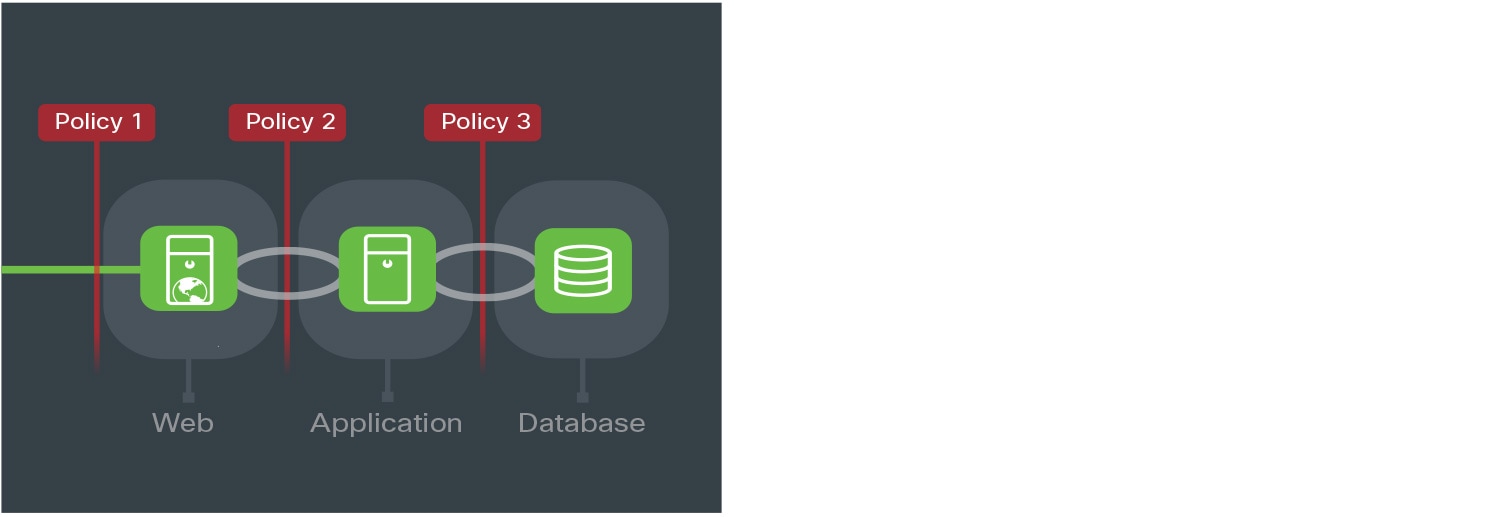
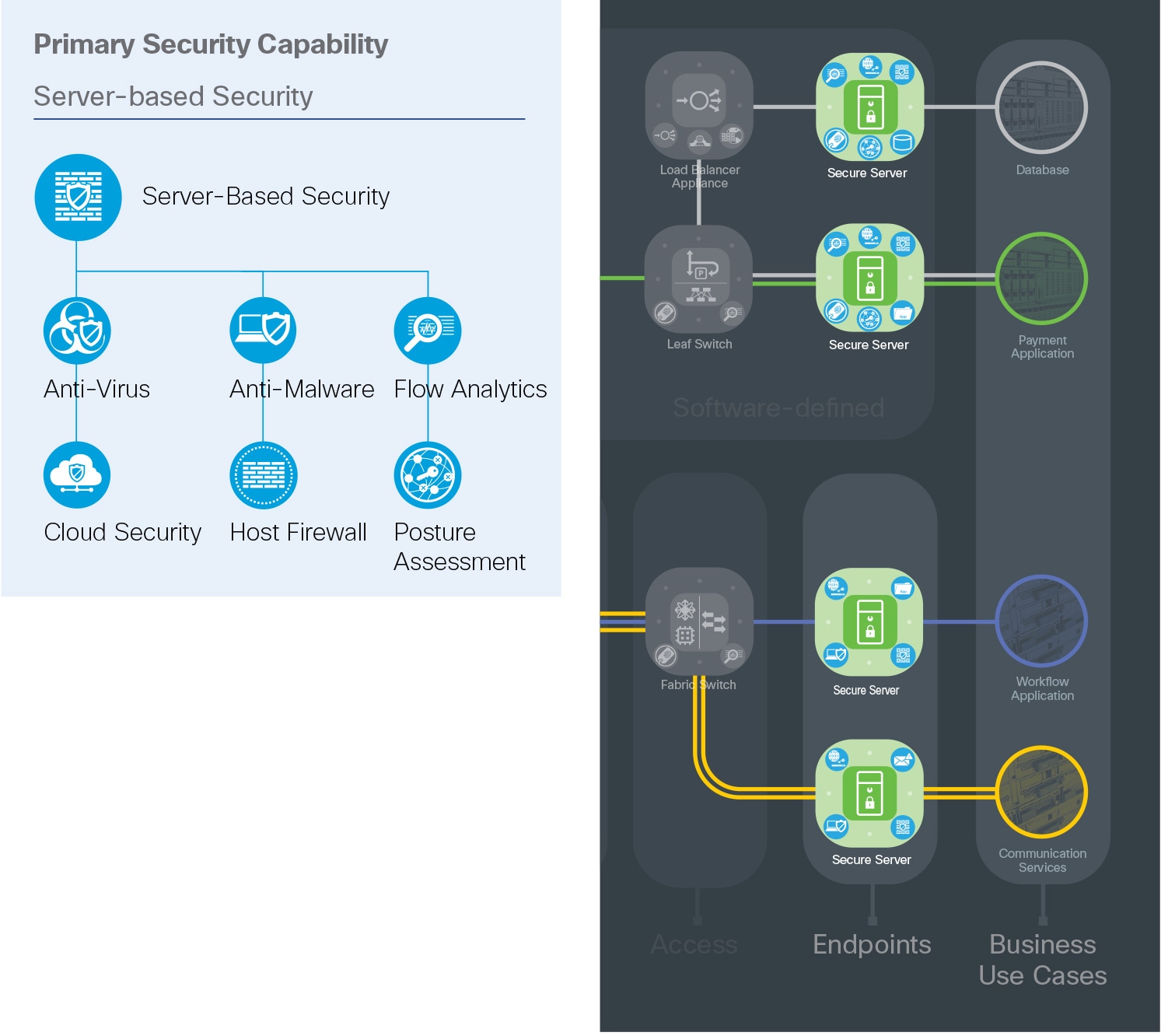
The Secure Data Center is complemented by a redundant data center where workloads are distributed. Alternatively, infrastructure can be ready in a warm standby data center or a cold data center where full backups are ready to deploy in the event of a complete failure.
Centralized management and shared services are the most common applications deployed in both, enabling full active/active redundancy. Connectivity between data centers is achieved via the WAN PIN or dedicated fiber connections to the cores when within the same metro area.
As the cost of cloud services decreases, many companies are deploying services in public service provider environments such as Amazon Web Services (AWS), Microsoft Azure, and Google Cloud Platform.
Application mobility to this infrastructure, shared services from this infrastructure, and dynamic scaling enable a hybrid data center architecture. Administration and monitoring must be secured using encryption (e.g., Cisco AnyConnect) and Cloud Access Security Broker (CASB) services such as Cisco Cloudlock.
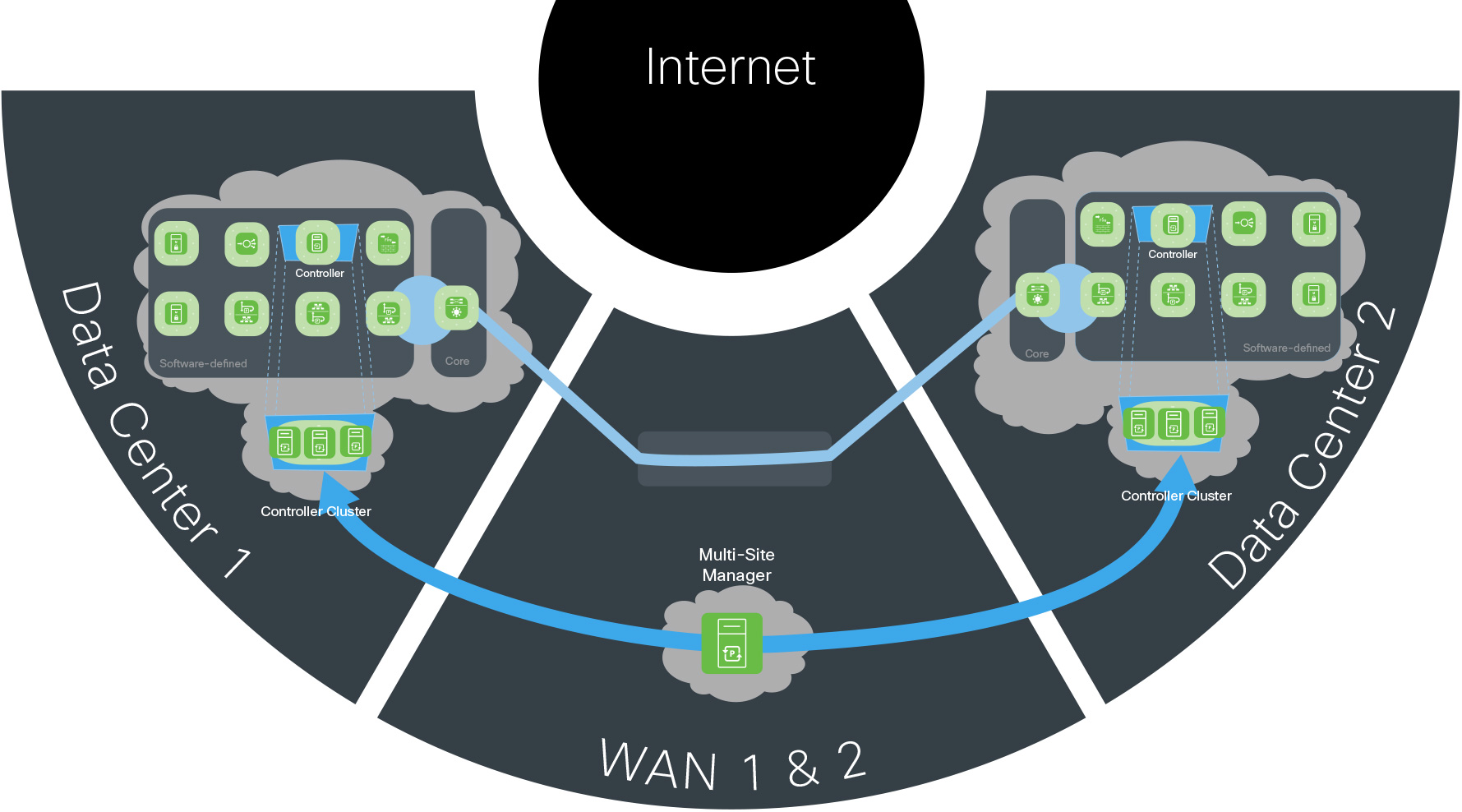
Today’s companies are threatened by increasingly sophisticated attacks. Data centers are targeted because they store all of a company’s data across increasingly complicated systems.
Cisco’s Secure Data Center architecture and solutions defend the business against corresponding threats using an architectural approach that overcomes the limitations of a point product offering.
SAFE is Cisco’s security reference architecture that simplifies the security challenges of today and prepares for the threats of tomorrow.
Appendix A - A Proposed Design
The Secure Data Center has been deployed in Cisco’s laboratories. Portions of the design have been validated and documentation is available on Cisco Design Zone.
Figures 19 and 20 depict the specific products that were selected within Cisco’s laboratories. It is important to note that the Secure Data Center architecture can produce many designs based on performance, redundancy, scale, and other factors. The architecture provides the required logical orientation of security capabilities that must be considered when selecting products to ensure that the documented business flows, threats, and requirements are met.
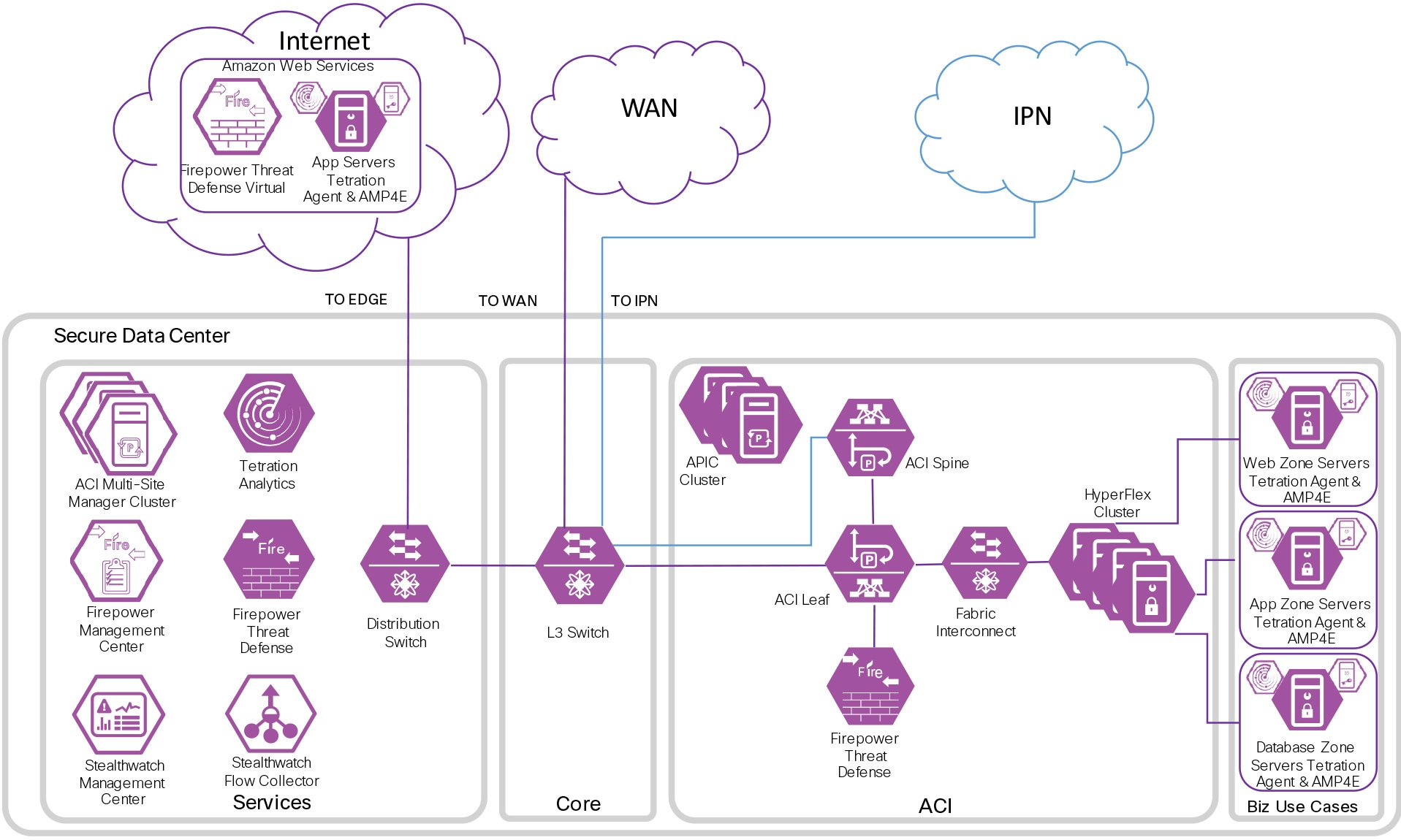
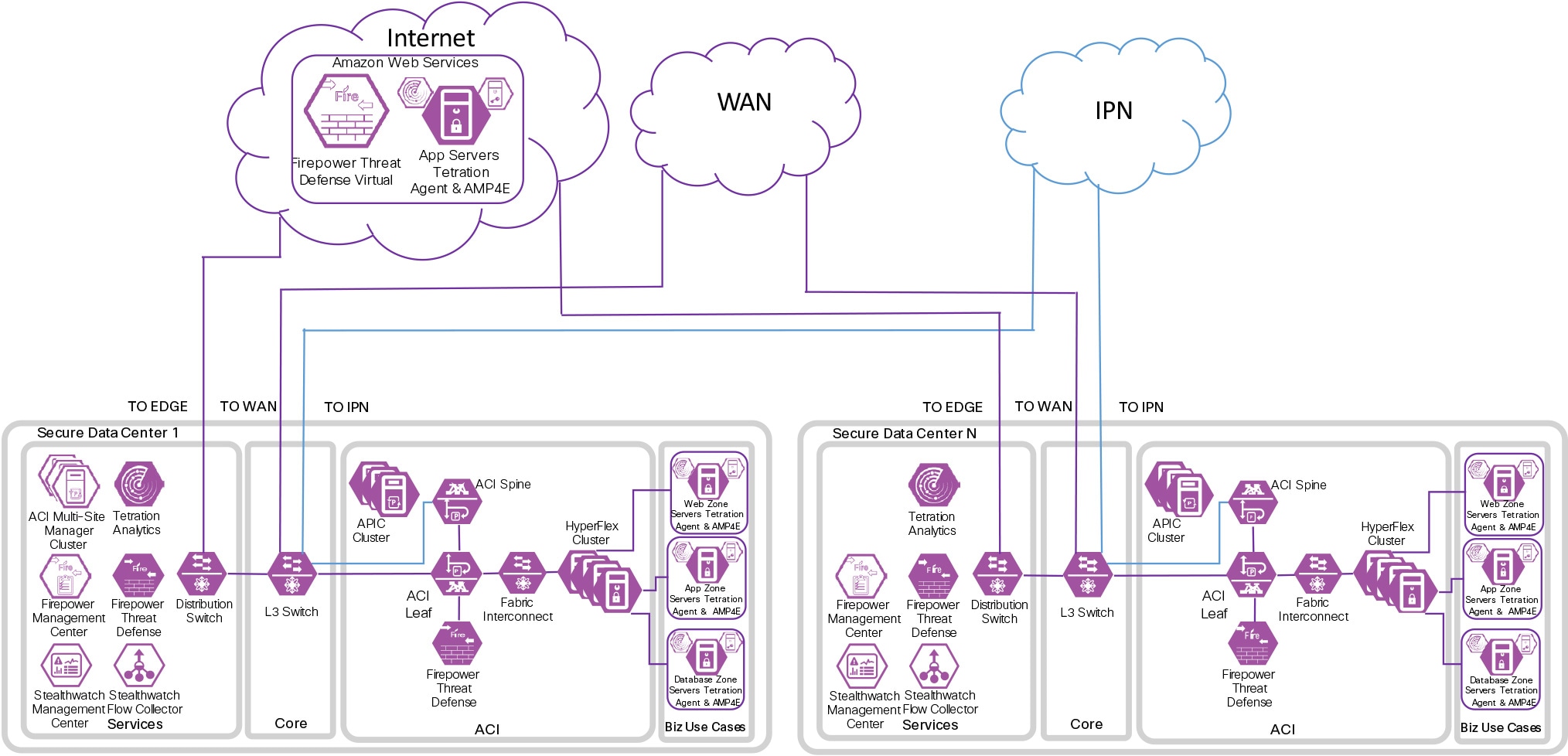
Appendix B - Suggested Components
| Data Center Attack Surface |
Security Capability |
Suggested Cisco Components |
||
| Human |
Users |
|
Identity |
Cisco Identity Services Engine (ISE) Cisco Secure Access by Duo Cisco Meraki Mobile Device Management |
| Network |
Wired Network |
|
Firewall |
Cisco Secure Firewall Threat Defense Virtual (FTDv) Cisco Adaptive Security Appliance Virtual (ASAv) Cisco Cloud Services Router (CSR) |
|
|
Intrusion Prevention System |
Cisco Secure Firewall Threat Defense Virtual Cisco Secure IPS Virtual |
||
|
|
Tagging |
Nexus/Catalyst/Meraki Switch VLANs TrustSec Application Centric Infrastructure (ACI) Endpoint Group (EPG) |
||
| Analysis |
|
Anti-Malware |
Cisco Secure Endpoint |
|
|
|
Threat Intelligence |
Talos Threat Intelligence |
||
|
|
Flow Analytics |
Cisco Secure Workload Cisco Secure Network Analytics Cisco Secure Cloud Analytics |
||
| Applications |
Application |
|
Application Visibility Control |
Cisco Secure Workload Cisco Secure Firewall Cloud Native Cisco Secure Firewall Threat Defense Virtual Cisco Adaptive Security Appliance Virtual Cisco Meraki Virtual MX |
|
|
Web Application Firewall |
Cisco Secure WAF |
||
|
|
Malware Sandbox |
Cisco Secure Malware Analytics |
||
|
|
TLS Encryption Offload |
Cisco Secure Application Delivery Controller (ADC) |
||
| Storage |
|
Disk Encryption |
Cloud Storage Provider |
|
| Server-Based Security |
|
Anti-Malware |
Cisco Secure Endpoint |
|
|
|
Anti-Virus |
Cisco Secure Endpoint |
||
|
|
Cloud Security |
Cisco Umbrella |
||
|
|
Host-based Firewall |
Cisco Secure Workload |
||
|
|
Posture Assessment |
Cisco Secure Endpoint Cisco Secure Access by Duo |
||
|
|
Disk Encryption |
Cisco Unified Computing System (UCS) Cisco Hyperflex |
||
|
|
Flow Analytics |
Cisco Secure Cloud Analytics Cisco Secure Workload |
||
|
|
Application Dependency Mapping |
Cisco Secure Workload |
||
|
|
Vulnerability Assessment and Software Inventory |
Cisco Secure Workload |
||
|
|
Process Anomaly Detection & Forensics: |
Cisco Secure Workload |
||
|
|
Tagging: Grouping for Software Defined Policy |
Cisco Secure Workload |
||
|
|
Policy Generation, Audit, and Change Management: |
Cisco Secure Workload |
||
If you have feedback on this design guide or any of the Cisco Security design guides, please send an email to ask-security-cvd@cisco.com.
For more information on SAFE, see www.cisco.com/go/SAFE.































































